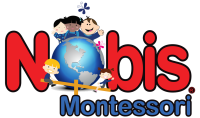OVERVIEW OF ELEMENTARY MATH CURRICULUM
The “Story of Numbers” helps children understand the power of mathematics and motivates them to continue exploring numbers. Progression through the Montessori math curriculum is not strictly linear. Instead, Maria Montessori envisioned elementary math as a three-tiered progression. The first tier consists of the numbers to ten, place value and the four operations. The second tier is dedicated to the memorization of math facts. The third tier is where the children study hierarchy, that is, how the numbers in the decimal system are related and grouped. The children explore different concepts of math simulation.
Children frequently ask for the biggest problems possible. They also enjoy writing their own BIG problems. The younger children practice using the materials representing whole numbers, fractions and decimals, and through repeated experiences with them, they “discover” algorithms or concepts by themselves or under the guidance of the teacher.
Montessori places great emphasis on the study of geometry, and all the math materials have a geometric aspect. Children in the lower elementary classrooms study lines, angles and plane figures, as well as linear and cubic measurement. In the upper elementary the children use boxes of cubes and prisms, which they previously manipulated in the primary classroom, to cube a binomial or trinomial. Through their studies, the students are able to discover abstract concepts of algebra, using materials that once were a part of their sensorial experiences.
The upper elementary children also take great delight in further study of different systems of numeration, both those used by ancient civilizations and other possible systems, such as base two or base twelve.

